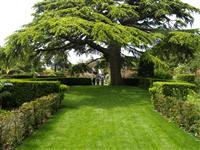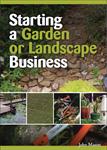Lawn Care
Lawns often look their worst in cooler weather; but that doesn’t need to be the case!
LAWN MAINTENANCE
MOWING
The most common mistake people make when looking after their lawn during winter is to cut the grass too often or too low. Because the lawn has slower growth and is less able to recover from stress, it is best to let it grow longer than at other times of the year. When you do cut the grass, never remove more than half of the leaf height. By doing this the lawn will be better able to adapt to winter conditions.
FERTILISING
Because the lawn isn’t actively growing during winter, there is not much point adding fertiliser. However, it is worth adding fertiliser during late autumn and early spring to help the lawn prepare for and recover from winter. Light, frequent applications of fertiliser are better than heavy, infrequent ones.
 DRAINAGE
DRAINAGE
Victorian gardens are often their wettest during winter. With this extra water, drainage becomes a priority. If your lawn is poorly drained, it is less able to absorb nutrients and becomes more prone to root diseases. It’s also unpleasant to walk on a soggy lawn. Before planting a lawn, establish a good drainage system. You may need to consult an expert – whilst this may cost money, you will recoup the costs in the long term and enjoy the benefits of a healthy lawn.
AERATION
Aeration and drainage really go hand in hand. Poor drainage starves grass roots of oxygen. This prevents the grass from absorbing nutrients. Aerating a lawn will help to overcome this problem, and professional turf managers will aerate their lawns regularly. This can take the form of “hollow tyning”, which is drilling tiny holes all over the lawn, or can be as simple as taking a garden fork and gently inserting into the lawn to allow air to get into the soil.
WATERING
Lawns can use a lot of water, and with water resources increasingly scarce, some may well question whether lawns should be eliminated completely.
Many people will however have lawns and rarely water them at all.
If you are growing hardy grasses and keeping your soil healthy, there should be little if any need to water a lawn in winter. If you don’t over use your lawn when growth is weak, you should be able to still have a lawn without the water even in summer too.
 CHOOSING A GRASS VARIETY
CHOOSING A GRASS VARIETY
Some grasses grow better in cooler weather and others better in warmer weather. The best lawns will contain a mix. If the summer varieties die out too much over winter, they can always be replaced in spring; and if you want to thicken up the winter varieties in winter, you can always topdress and so a little winter variety grass seed in autumn or early winter.
WHAT ARE COOL AND WARM SEASON GRASSES?
Lawn grasses are divided into two categories by their growth performance under different environmental conditions.
|
|
Cool Season Grasses
|
Warm Season Grasses
|
|
Preferred temperature
|
16-24 Degrees Celsius
|
27-30 Degrees Celsius
|
|
Examples
|
Bent, Fescue, Ryegrass
|
Kikuyu, Buffalo, Couch
|
|
Advantages
|
Perform well in partial shade
|
Tolerant of mowing
|
|
Problems
|
Susceptible to leaf diseases in humid areas; need lots of water
|
Many become dormant and brown in Winter; also have a habit of creeping into garden beds
|
|
|
|
|
WINTER LAWN PROBLEMS (AND THEIR SOLUTIONS)
PROBLEM 1 - SLOW GROWTH
Because there is less light during winter, lawns grow more slowly. This means diseases, pests, diseases and other adverse conditions have a bigger impact in winter.
SOLUTION
Keep your lawn strong in winter. Fertilising the lawn can keep growth going a little longer in autumn and encourage stronger growth sooner in spring…in effect shortening the effect of winter.
PROBLEM 2 - WET SOIL
In temperate areas, soil can become very wet in winter. This excess moisture can starve grasses of oxygen, thereby stopping the plant from getting enough nutrients like Nitrogen. This makes the grass turn yellow.
SOLUTION
The only solution to saturated soil in winter is to improve your drainage system.
PROBLEM 3 – DORMANCY
Some lawn varieties (eg. couch) become dormant during winter and turn brown. This is usually a problem when warm season grasses are grown in southern Australia, as they naturally “shut down” for the winter.
SOLUTION
You can over sow winter dormant grasses with a winter growing variety. For example, plant annual rye grass over the top of couch.
PROBLEM 4 - WEEDS
During winter, weeds are more likely to creep into a lawn because the competition from the turf is not as strong.
SOLUTION
Fertilise in autumn to improve the winter vigour of your lawn.
One of the most important things is to mow or remove weeds before flowers mature to produce seeds. Seeds take weeds into garden beds and other unwanted places; but weeds that are regularly mown just create a patchy appearance on the lawn surface.
In cool areas use a cool season grasses that don’t turn dormant in the winter. If you live in a mild areas (eg. Coastal regions), choose creeping grasses like buffalo and couch. These can form a dense mat on the ground, and are much more resistant to weed invasion than non-creeping grasses.
Alternatively, learn to accept the weed growth. Many weeds can be mown, and while a weed infested lawn may look patchy; it can still be green, provide a place for children to play, and keep the dust down.
A high quality lawn may be lovely, and desirable; but it may also be difficult and costly to sustain with the likelihood of water restrictions in summer.
Perhaps getting used to a few weeds in the lawn may be a necessity for water conscious gardeners of the future.
Want to Know More?
Consider doing a course or buying a reference book from our school.
If you would like to communicate with one of our professional tutors, consider using our free career counselling service, to help you decide of a learning and career development direction that is tailored to your needs. click for details
If you want to browse our bookshop, go to www.acsbookshop.com
To browse our courses, go to http://www.acsgarden.com/Courses/Default.aspx
VISIT OUR ACS ONLINE E BOOKSTORE
 Quality ebooks written by our staff
Quality ebooks written by our staff- Wide range of Horticulture titles by John Mason, author of over 40 gardening books, garden magazine editor, nurseryman, landscaper and principal of ACS.
- Ebooks can be purchased online and downloaded straight away.
- Read on an ipad, computer, iphone, reader or similar device.
- New titles published every month –bookmark and revisit this site regularly
- Download sample pages for free, to see what each book is like.
More from ACS
Ebook - Growing and using grasses and grass like plants: identify, cultivate illustrated encyclopedia
View eBook
Ebook - Inspiring: covers formal, natural, eclectic, modern, oriental, Mediterranean; zoom in on stunning images and plans.
View eBook